Search Results
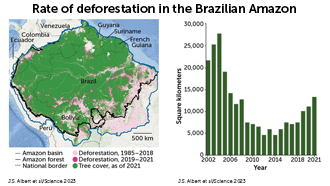
Amazon deforestation
Scientists agree that the Amazon is in grave trouble because of human activities, such as deforestation, and climate change. Past studies have suggested certain rates of deforestation would trigger the Amazon to transform into a savanna, but many scientists now say the forest probably doesn’t have a single, clear tipping point. Still, researchers are working to understand what needs to be done — and how soon — to save the forest. Use the map and graph titled “Rate of deforestation in the Brazilian Amazon” to have students analyze the area and rate of deforestation in the Amazon.
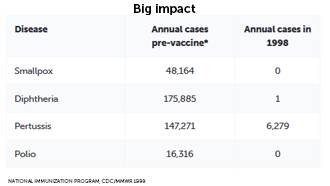
Disease eradication data
The success of vaccines has sometimes obscured the power of infectious diseases to sicken, kill and upend lives. Still, the epidemics of the last century contain stories to listen to and learn from. Use the data table “Big Impact” to have students analyze how vaccines have impacted the number of disease cases.
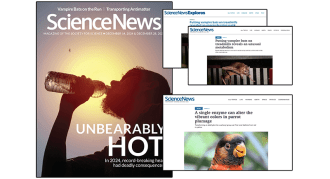
Parrot Pigmentation and Bat Metabolism
Incorporate articles from the December 14 & 28 Science News issue to introduce the importance of functional groups using the pigments aldehyde and carboxyl psittacofulvin found in parrots and to discuss how chemical analysis can support conclusions made about the metabolism of vampire bats.
Parrot pigmentation by functional group
Scientists have discovered an enzyme that helps oxidize the pigment aldehyde psittacofulvin, which colors parrot feathers red, to carboxyl psittacofulvin, a yellow pigment. After reviewing the basics of molecular structure and bonding, use this activity to introduce functional groups to students before having the students describe how different pigments might create the feather colors in a photo of a parrot. Finally, discuss the importance of understanding properties and reactivity of functional groups.
Treadmill-sprinting vampire bats
Learn how scientists use vampire bats' unusual locomotion to investigate mysteries of their blood-based metabolism. Then, answer questions about this study’s experimental design and discuss how chemical analysis data can support conclusions and answer scientific questions.
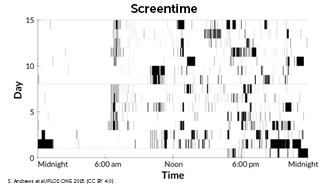
Smartphone Behavior
Smartphone use is changing human behavior and likely influencing our brains. New research is turning up clues as to how our interaction with devices is shaping our memory, navigation and even our happiness. Use the data visualization “Screentime” and graph “What am I missing” to have students analyze data on phone use and behavior.
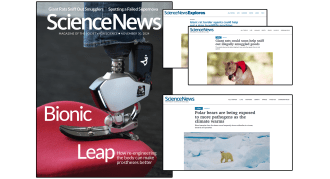
Polar Bear Pathogens and Rat Training
Review the major components of the immune system then have students investigate lifecycles of pathogens and the possibility of polar bear exposure to them and discuss the ethics of experimental design using a rat training study with articles from the November 20 issue of Science News.
Immunity and polar bear pathogens
Students will learn how their bodies help protect them from bacteria, viruses and other foreign invaders. Have students review the major components of the immune system and investigate the life cycles of a few prevalent pathogens of polar bears, focusing on the mode of transmission and effects of being infected by the pathogen. Students will then infer why polar bears are being exposed to these pathogens more regularly.
Giant rats in training
Wildlife smugglers beware: A new border-patrol agent may scurry into nearby airports. Learn how African giant pouched rats in tiny red vests are being trained to sniff out elephant ivory and other illegal goods from at-risk species. Then answer questions about the ethics of the experimental design of animal studies and the value of biodiversity.
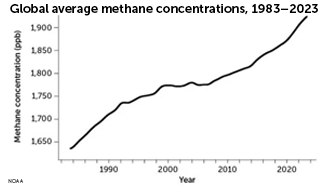
Methane in the Atmosphere
To tackle our warming climate, we’ll need to rein in emissions of carbon dioxide, but there’s another greenhouse gas at play: methane. Decreasing methane concentrations may be the best bet for stopping rising temperatures in the short term.
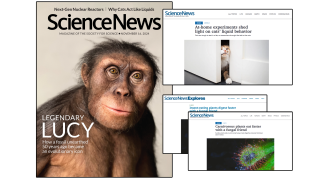
Liquid Cats and Exciting Enzymes
Use a carnivorous plant enzyme and an enzyme from a symbiotic fungal friend to introduce catalysts to your students before having them investigate their own example and potential applications and show popular “liquid cat” in-home experiments to teach about experimental design.
Cats are liquid
"Cats are liquid." You may have heard this playful saying before. Cats earn a reputation for oozing in and out of some tight spots. But lately, some scientists started wondering whether they’d fit through an opening of any size. Learn how scientists have developed controlled in-home experiments to address such questions scientifically. Answer questions about independent and dependent variables and compare two similar experiments in terms of experimental design.